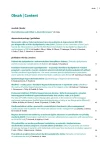MedPed – the reality of familial hypercholesterolemia care at the biggest center
Authors:
Martina Vaclová 1; Tomáš Freiberger 2; Lucie Schwarzová 1; Lukáš Tichý 3; Michal Vrablík 1; Richard Češka 1
Authors‘ workplace:
III. interní klinika 1. LF UK a VFN v Praze
1; Centrum kardiovaskulární a transplantační chirurgie, Brno
2; Centrum molekulární biologie a genové terapie, Interní hematologická a onkologická klinika, FN Brno, pracoviště Bohunice
3
Published in:
Vnitř Lék 2018; 64(1): 38-42
Category:
Reviews
Overview
The MedPed project (Make Early Diagnosis to Prevent Early Deaths) aiming at screening, diagnosis and treatment of patients with familial hypercholesterolemia (FH) was initiated more than 19 years ago. More than 60 cooperating centers and a large number of health care professionals have been involved. Till November 15, 2017 the nationwide database has comprised 7 567 entries of individual FH patients, 439 of these being children up to 19 years of age. Given the recently corrected estimated population frequency of FH of 1 to 250 this number represents 18.9 % of the predicted number of 40 000 FH individuals in the Czech Republic. Although the number of patients captured by the database seems to be relatively low, it is the third highest number in the world. This review describes working procedures of one of the national leading centers for FH in the Czech Republic. Additionally, a comparison of the up-to-date data set of 558 FH individuals being actively followed in the center to the original FH cohort (n = 190) as described by prof. Sobra in the late 1960 s. is being discussed.
Key words:
familial hypercholesterolemia – heterozygous – homozygous – project Medped
Sources
1. Sjouke B, Kusters DM, Kindt I et al. Homozygous autosomal dominant hypercholesterolemia in the Netherlands: prevalence, genotype-fenotype relationship, and clinical outcome. Eur Heart J 2015; 36(9): 560–565. Dostupné z DOI: <http://dx.doi.org/10.1093/eurheartj/ehu058>.
2. Freiberger T, Vrablík M. 15 let projektu MedPed v České republice. Hypertenze a KV prevence 2013, 2(5): 58–60.
3. Vrablík M, Vaclová M, Tichý L et al. Familial Hypercholesterolemia in the Czech Republic: More Than 17 Years of Systematic Screening Within the MedPed Project. Physiol Res 2017; 66(Suppl 1): S1-S9.
4. [Česká společnost pro aterosklerózu ]. Projekt MedPed. Dostupné z WWW: <http://www.athero.cz/projekt-medped/>.
5. [Česká společnost pro aterosklerózu]. Projekt MedPed – Pro pacienty – Mám FH? Dostupné z WWW: <http://www.athero.cz/projekt-medped/pro-pacienty/mám-fh/>.
6. Vallejo-Vaz AJ, Kondapally Seshasai SR, Cole D et al. Familial hypercholesterolaemia: A global call to arms. Atherosclerosis 2015; 243(1): 257–259. Dostupné z DOI: <http://dx.doi.org/10.1016/j.atherosclerosis.2015.09.021>.
7. Benn M, Watts GF, Tybjaerg-Hansen A et al. Familial hypercholesterolemia in the danish general population: prevalence, coronary artery disease, and cholesterol-lowering medication. J Clin Endocrinol Metab 2012; 97(11): 3956–3964. Dostupné z DOI: <http://dx.doi.org/10.1210/jc.2012–1563>. Erratum in J Clin Endocrinol Metab 2014; 99(12): 4758–4759.
8. Šobra J. Familiární hypercholesterolemická xanthomatosa. Avicenum: Praha 1970.
9. Tsouli SG, Xydis V, Argyropoulou MI et al. Regression of Achilles tendon thickness after statin treatment in patients with familial hypercholesterolemia: an ultrasonographic study. Atherosclerosis 2009; 205(1): 151–155. Dostupné z DOI: <http://dx.doi.org/10.1016/j.atherosclerosis.2008.10.032>.
10. Civeira F, Perez-Calahorra S, Mateo-Gallego R. Rapid resolution of xanthelasmas after treatment with alirocumab. J Clin Lipidol 2016; 10(5): 1259–1261. Dostupné z DOI: <http://dx.doi.org/10.1016/j.jacl.2016.07.007>.
Labels
Diabetology Endocrinology Internal medicineArticle was published in
Internal Medicine

2018 Issue 1
Most read in this issue
- Familial combined hyperlipidemia – the most common genetic dyslipidemia in population and in patients with premature atherothrombotic cardiovascular disease
- Epidemiology of hypercholesterolemia
- Diabetic dyslipidemia and microvascular complications of diabetes
- The current position of hydrochlorothiazide among thiazide and thiazide-like diuretics
